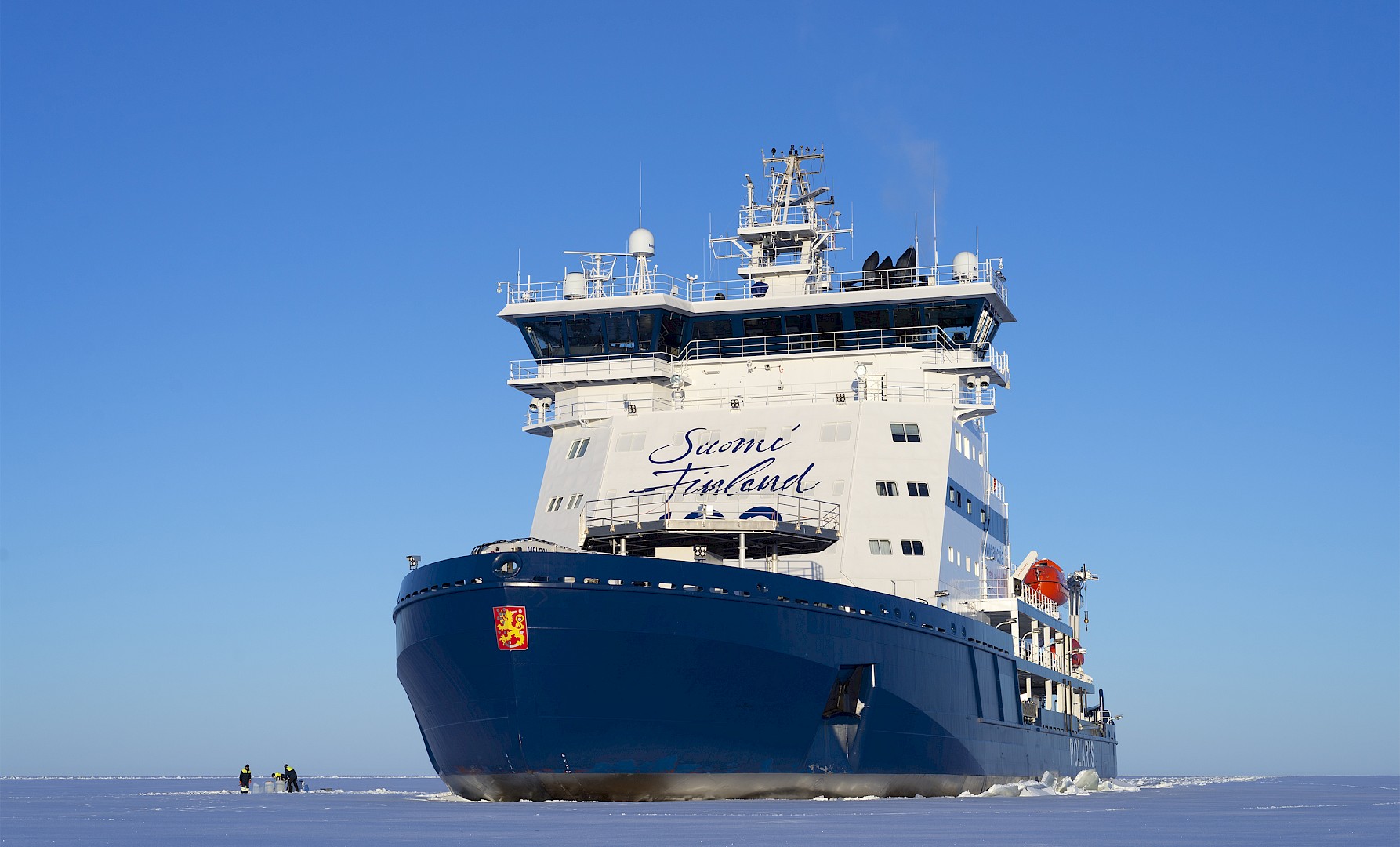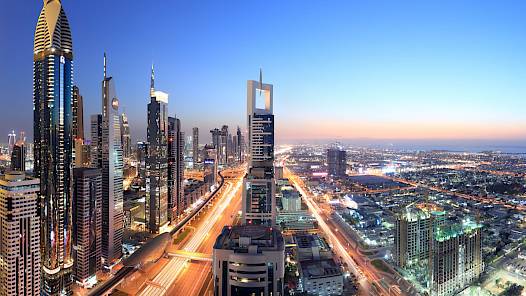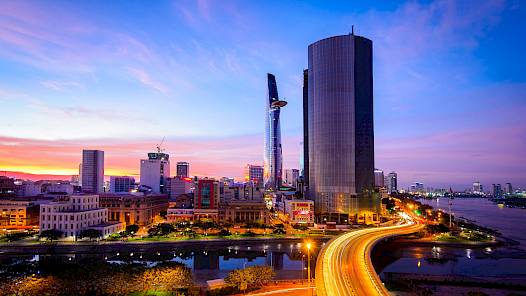Navigating Arctic ambitions: Opportunities and risks for Finland’s icebreaker industry
12 August 2025 — The Arctic region has emerged as a strategic focal point due to its vast economic potential and intensifying geopolitical competition. Finland is well-positioned to seize significant opportunities by strategically navigating complex opportunities and risks.

Download this post (PDF)
The Arctic is becoming a key arena in global geopolitics and economics. As climate change accelerates, melting ice is opening northern sea routes and revealing vast untapped resources – estimated to include 13% of the world’s undiscovered oil and 30% of its natural gas[1]. New trans-Arctic shipping lanes, such as the Northern Sea Route, could dramatically shorten Asia–Europe trade by bypassing the Suez Canal[2], intensifying global interest. With the region becoming more accessible, major powers are moving quickly to shape their Arctic strategies.
International ambitions in the Arctic drive demand for icebreakers
Global players are stepping up their Arctic ambitions, driven by strategic and economic interests – many of which hinge on icebreaking capabilities.
Russia today fields the world’s largest icebreaker fleet and maintains more Arctic bases than all NATO countries combined. The region is central to Moscow’s vision of future economic and geopolitical power. It has invested heavily to develop the Northern Sea Route (NSR) along Siberia into a major shipping corridor to rival traditional routes. The NSR’s appeal is a much shorter voyage between Asia and Europe, and Russia is striving to make it a year-round artery. Russia’s state-owned icebreaker fleet is expanding, including launching new nuclear-powered icebreakers (Project 22220 class) designed to clear 3-meter-thick ice and keep the NSR open year-round. By 2030, Russia plans to have at least seven of these new nuclear icebreakers in service, which officials claim would enable uninterrupted NSR transit in all seasons[4].
Alongside economic aims, Moscow has markedly militarized the Arctic. Since 2005, Russia has reopened dozens of Soviet-era Arctic military bases and upgraded Arctic infrastructure. Its Northern Fleet was elevated into a separate military district to prioritize Arctic defence. Notably, it launched the Ivan Papanin – the first armed, combat-capable icebreaker – which underwent sea trials in 2024 and is slated to join the Navy’s Arctic fleet. This dual civilian-military use of icebreakers underscores Russia’s intent to secure its Arctic domain.
China is expanding its Arctic footprint through investment and a growing fleet, marrying economic aims with strategic positioning as a rising polar power. China, though not an Arctic nation, declares itself a “near-Arctic state” and has woven the Arctic into its global Belt and Road Initiative under the banner of the “Polar Silk Road.” This strategy, introduced in a 2018 policy white paper, signals China’s intent to integrate Arctic shipping lanes and resources into its trade network. In practice, China is investing in Arctic infrastructure and energy projects. For example, Chinese state firms hold significant stakes in Russia’s Yamal LNG and Arctic LNG 2 projects, which are among the largest Arctic energy investments[6]. Beijing has also sought port and mining opportunities across the circumpolar north from Russia’s Northern Sea Route infrastructure to mines in Greenland as it diversifies resource supplies.
On the shipping front, China is rapidly expanding its ice-class fleet. It operates three polar icebreakers, which support its dual-purpose scientific and strategic activities in high latitudes. Chinese ice-capable cargo ships have also begun seasonal transits of the NSR, and a Chinese shipping firm in 2024 announced plans with Russia to construct five Arc7 ice-strengthened container ships for year-round Arctic service. These moves align with China’s goal to eventually ship goods to Europe via the Arctic. Diplomatically, China presses for treating the Arctic as a global common to gain a larger governance role.
United States is driving icebreaker modernization for securing its interest in Arctic. The United States has historically lagged in icebreaking capacity but is now undertaking a long-delayed modernization of its icebreaker fleet. The U.S. Coast Guard currently has only two operational polar-capable icebreakers, which struggle to meet mission demands in the Arctic and Antarctic. A 2023 Coast Guard assessment found that the U.S. will need at least 8 to 9 polar icebreakers in the coming years – 4 to 5 of them heavy – to effectively protect its Arctic interests[7]. The U.S. has launched the Polar Security Cutter (PSC) program to build new heavy icebreakers already in 2012, but the program has been plagued by delays, with the first vessel projected to be operational in 2030 instead of 2024 as originally planned. The first PSC is now under construction, with two more funded and plans for additional medium icebreakers afterward. These new vessels, armed and multi-mission, will enable year-round U.S. presence in polar waters for tasks ranging from sea-lane clearance, search-and-rescue missions, and national defence. The U.S. and NATO allies have ramped up Arctic military exercises and surveillance, and the U.S. created a dedicated Arctic Ambassador role to coordinate policy. Infrastructure investments are also underway to improve Arctic operational reach. Notably, the U.S. is developing its first deep-water Arctic port at Nome, Alaska, to support larger Coast Guard and Navy vessels in the far north.
Canada drives its Arctic strategy to assert sovereignty and improve capabilities (ships and ports) for security and sustainable development in its Arctic territories. For Canada, the Arctic is a core part of national identity and sovereignty. A top concern is control over the Northwest Passage (NWP) – the sea route through Canada’s Arctic Archipelago. Canada maintains that the NWP constitutes internal Canadian waters, whereas the United States and others argue it is an international strait[8]. Meanwhile, Canada is modernizing its Arctic capabilities, especially its aging icebreaker fleet. Under its National Shipbuilding Strategy, Canada committed to acquire two new heavy polar icebreakers for the Canadian Coast Guard. Notably, Finnish expertise is contributing to this effort: Davie will leverage its subsidiary Helsinki Shipyard in Finland to construct sections of its icebreaker, with Finnish engineers guiding Canadian workers – a partnership to share know-how under the new ICE Pact[9].
The Nordic countries – notably Norway, as well as Sweden, Denmark (Greenland), and Finland itself – approach the Arctic with an emphasis on international cooperation, sustainable development, and technological innovation. Norway in particular, which is home to the Arctic Archipelago of Svalbard and vast northern coastlines, has prioritized environmental stewardship and sustainable use of Arctic resources in its policies. As the current chair of the Arctic Council (2023–2025), Norway has focused the Council’s agenda on climate change, ocean health, and the well-being of indigenous peoples. Nordic governments consistently advocate for protecting the fragile Arctic ecosystem even as economic activity grows.
At the same time, the Nordics recognize strong opportunities in green technology and energy in the Arctic. Renewable energy leadership is a hallmark of these countries. Green shipping technology is a major focus across Nordic maritime industries. Norway has pioneered electric ferries and battery-hybrid vessels along its coast, and it is exploring hydrogen and ammonia fuels for ships to cut carbon and pollutant output. In Sweden and Finland, new icebreaker designs are embracing cleaner propulsion. The Nordic approach marries economic development with sustainability – pursuing clean energy, low-impact shipping, and regional cooperation to ensure the Arctic’s future is both prosperous and environmentally sound.
Implications for Finnish icebreaker companies: seizing opportunities while mitigating threats
Finland enters this scene with a longstanding niche expertise: icebreakers. Nearly every Finnish port freezes over in winter, compelling Finland to master icebreaking technology decades ago. Today, Finland is a global leader in icebreaker shipbuilding – about 80% of the world’s icebreakers are designed by Finnish firms, and over 60% are built in Finnish shipyards[9]. This hard-earned expertise – from innovative hull designs to efficient propulsion in ice – has made Finland an icebreaker superpower. At the same time, thick ice of the Arctic provides still learning opportunities, as most earlier icebreakers have been designed for primarily first- or second-year ice conditions and not multi-year ice. As great-power competition and commercial activity grow in the Arctic, Finnish policymakers and industry leaders recognize both an opportunity and a responsibility: to leverage Finland’s icebreaker leadership in a changing Arctic, while navigating the geopolitical and market risks that come with it.
Finland’s icebreaker industry, working closely with the government, should pursue several strategic actions:
- Aggressively target global icebreaker contracts: Finnish shipbuilders and designers should actively pursue and win international icebreaker contracts. With the ICE Pact gaining momentum, opportunities are opening to support allies – such as securing subcontracts in the U.S. Polar Security Cutter program or meeting Canada’s growing icebreaking needs. This might involve tailored marketing to Arctic nations and emerging players such as providing designs for Indian or Japanese polar vessels. Finnish companies can also offer lease or charter options to countries hesitant to invest in their own fleet, effectively exporting icebreaking as a service
- Invest in R&D for green and autonomous technologies: To maintain competitive edge, Finnish firms must invest in next-generation icebreaker tech. This includes developing low-emission propulsion (LNG, biofuels, methanol, hydrogen fuel cells) and meeting upcoming environmental rules proactively. The IMO’s ban on heavy fuel oil in the Arctic makes such innovation essential. Simultaneously, R&D in digital systems (autonomous navigation, remote vessel monitoring, and ice prediction software) can create high-value exports (not just ships, but also software and consulting services). Partnerships with Finnish universities and tapping programs like Business Finland can support these innovation efforts
- Deepen government-industry collaboration: Finnish government support is vital to compete internationally in what is often a state-driven market. Closer coordination, building on Finland’s tradition of public-private cooperation in shipbuilding, can help in multiple ways: 1) diplomatic lobbying: government officials should actively promote Finnish icebreaker solutions in bilateral talks and trade missions; 2) co-financing and guarantees: icebreaker projects are capital-intensive; Finnish export credit agencies and government funds could provide financing packages to help buyers choose Finnish-built vessels; 3) ensuring a stable home market: planning and funding the renewal of Finland’s own icebreaker fleet will give the yards predictable work and a showcase project
- Foster strategic alliances and joint ventures: Finnish companies should consider joint ventures with foreign yards or firms to extend their reach. For instance, partnering with an American shipyard (as technology provider) could ease U.S. political concerns and secure work under “Buy American” constraints. The new arrangement between Helsinki Shipyard and Canada’s Davie is a model of a win-win JV leveraging Finnish expertise abroad. Similar approaches could target other markets. For example, a partnership with a Japanese or Korean yard is possible to build ice-class LNG tankers using Finnish designs, capturing commercial opportunities in Arctic energy transport. Alliances can also help tackle large projects by sharing risk and resources
However, the Arctic’s geopolitical climate poses uncertainty. Future political rifts could similarly affect access to markets like China or limit technology transfer. Finnish companies risk being caught between great-power rivalries or losing business if tensions spike and international Arctic cooperation frays. Mitigation requires diversification of clients by reducing reliance on any single country and close alignment with Finland’s foreign policy to avoid prohibited dealings. It also underscores the importance of friendshoring, which focuses on friendly nations’ projects to reduce geopolitical risk.
In conclusion, Finland’s icebreaker industry stands at a crossroads of unprecedented opportunity tempered by significant challenges. By taking bold, strategic actions, such as targeting growing Arctic markets, innovating relentlessly, and partnering wisely, Finland can reinforce its position as the global leader in icebreakers. Yet it must do so with eyes open to the risks of a shifting geopolitical landscape and rapid technological change. With a balanced, forward-looking strategy that leverages Finland’s strengths in engineering and diplomacy, Finnish policymakers and industry leaders can ensure that Finland’s icebreaker companies not only survive but thrive in the new Arctic era. Finland’s continued leadership in sustainable icebreaker innovation, in partnership with like-minded nations, will help steer the course of Arctic development toward cooperation, safety, and environmental responsibility – a fitting role for a country uniquely skilled in navigating the world’s iciest waters.
References:
Header image: Finnish LNG-powered icebreaker Polaris during full-scale ice trials in the Gulf of Bothnia on 24 March 2017 by Tuomas Romu, licensed under CC BY-SA 4.0, via Wikimedia Commons.
[1] U.S. Energy Information Administration. Arctic oil and natural gas resources.
[2] Arctic Economic Council. The state of maritime transportation in the Arctic.
[3] The Jamestown Foundation. Russia prioritizes icebreakers in scramble for Arctic. Retrieved from https://jamestown.org/program/russia-prioritizes-icebreakers-in-scramble-for-arctic-part-one/
[4] Reuters. Dark Arctic. Retrieved from https://www.reuters.com/graphics/ARCTIC-SECURITY/zgvobmblrpd/
[5] The Arctic Institute. China’s Polar Silk Road: Long Game or Failed Strategy. Retrieved from https://www.thearcticinstitute.org/china-polar-silk-road-long-game-failed-strategy/
[6] U.S. Congress. Coast Guard Polar Security Cutter (PSC) and Arctic Security Cutter (ASC) Icebreaker Programs: Background and Issues for Congress. Retrieved from https://www.congress.gov/crs-product/RL34391
[7] The Arctic Institute. Canada's National Shipbuilding Procurement Strategy: New Capabilities for Arctic. Retrieved from https://www.thearcticinstitute.org/canada-national-shipbuilding-arctic/
[8] Government of Canada. Construction of new polar icebreakers for the Canadian Coast Guard. Retrieved from https://www.canada.ca/en/public-services-procurement/news/2025/03/construction-of-new-polar-icebreakers-for-the-canadian-coast-guard.html
[9] Wilson Center. Icebreaking Explained – Finland: Europe’s Icebreaker Superpower. Retrieved from https://www.wilsoncenter.org/article/icebreaking-explained-finland-europes-icebreaker-superpower
Tags
Finnish economy, Icebreaking industry, Growth strategy, Arctic region










